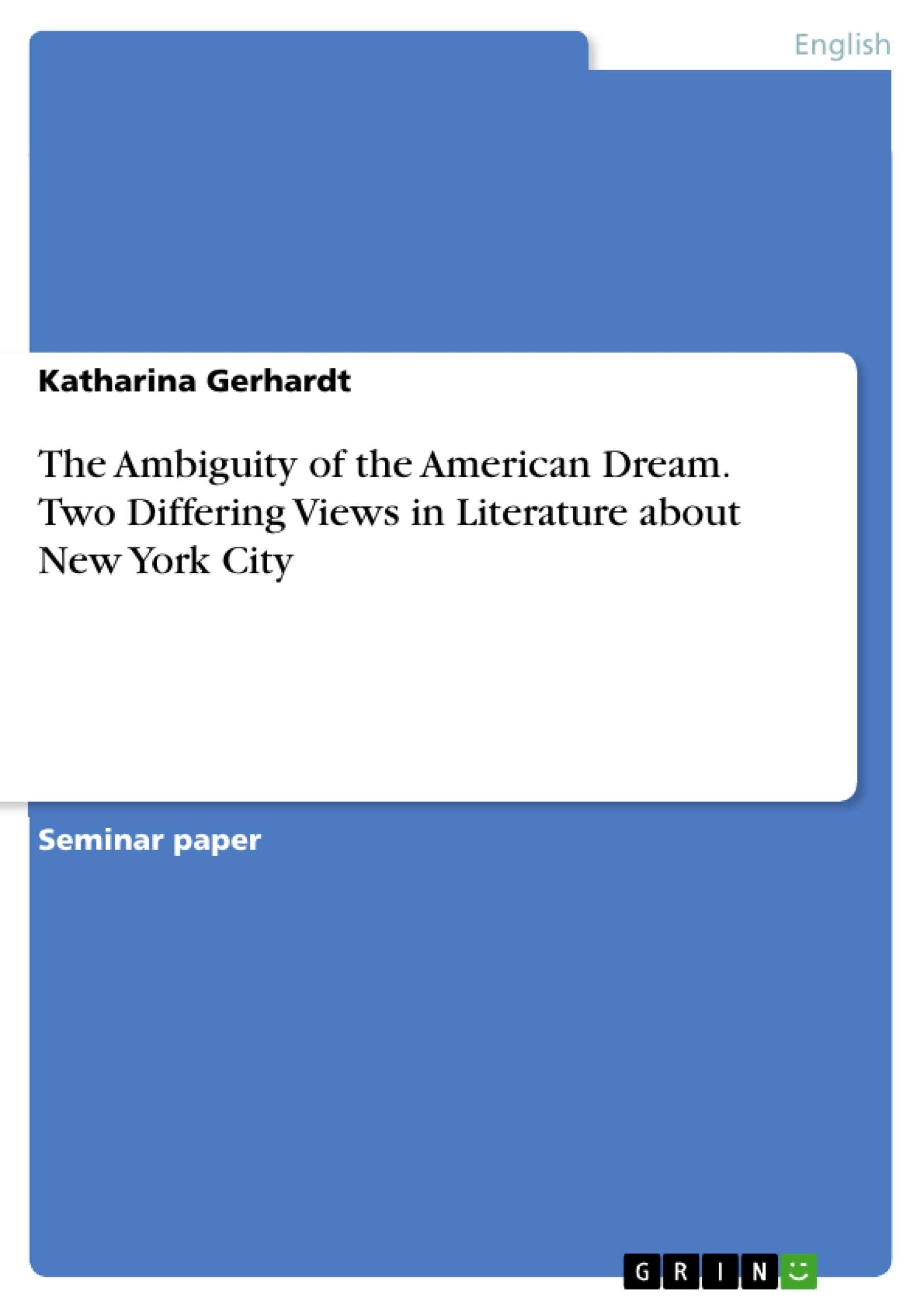The American Dream is one of the most essential myths in American history. To this day its meaning and value are a vital part of American culture, but since it is such a powerful and influential concept, it is also the object of manifold interpretations, which at times turn out to be opposing.
In my paper, I will compare the different ideas on the American Dream in F. Scott Fitzgerald's The Great Gatsby and Emma Lazarus's poem "The New Colossus". While Fitzgerald presents a rather negative view of the American Dream, leaving us with the notion that although we know that we must eventually fail in trying to achieve our goals, we still keep on trying. Lazarus on the other hand presents the reader with the positive side of the American Dream and New York when she says that everyone is welcome, no matter what their background is, everyone has a chance to achieve a better life in the city. This shows that in a way New York was a symbol for the American Dream, because for many the city stood for a better life and the possibility to achieve your dreams during the time when these two works were written. Lazarus includes everyone in her poem, whereas Fitzgerald leaves out real success stories and different races are portrayed negatively.
Therefore, it can be said that although both might present parts of the ‘reality’ of the American Dream and its impact on society, they still offer very narrow and incomplete images of it, since both of them stay focused on specific (also subjective) views of this myth and the city of New York. In order to show this, I will first analyze The Great Gatsby and the idea of the American Dream Fitzgerald presents in it. Then I will describe Emma Lazarus’s role in the shaping of the American Dream and how her words also partially oppose reality. I will then continue to analyze the ambiguity of the American Dream and New York as a city of dreams, fascination and new beginnings, but also of failure and lost hopes as it is presented in The Great Gatsby and in Lazarus’s poem.
Table of Contents
- Introduction
- Main Part
- The American Dream and New York in The Great Gatsby
- The American Dream and New York in \"The New Colossus\"
- The Ambiguity of the American Dream and New York
- Conclusion
- List of Works Cited
Objectives and Key Themes
This paper analyzes the portrayal of the American Dream in F. Scott Fitzgerald's The Great Gatsby and Emma Lazarus's poem "The New Colossus", highlighting the contrasting perspectives on its meaning and attainability in the context of New York City. While Fitzgerald presents a critical view, emphasizing the elusive nature of success and the inherent limitations of the Dream, Lazarus offers a more optimistic vision of opportunity and inclusion. This exploration sheds light on the complex and often ambiguous reality of the American Dream, exploring its social, economic, and cultural implications.
- The American Dream as a powerful myth in American history
- Contrasting perspectives on the American Dream in literature
- The role of New York City as a symbol of opportunity and ambition
- The potential for disillusionment and failure in the pursuit of the American Dream
- The representation of race and class in the context of the American Dream
Chapter Summaries
- Introduction: This chapter introduces the concept of the American Dream and its multifaceted interpretations, particularly focusing on the contrasting perspectives presented in The Great Gatsby and "The New Colossus." It highlights how both works portray New York City as a central symbol for the American Dream, but with different interpretations of its promise and limitations.
- The American Dream and New York in The Great Gatsby: This chapter examines the depiction of the American Dream in The Great Gatsby, focusing on Gatsby's relentless pursuit of success and wealth. It explores the allure of New York City as a place of opportunity and reinvention, while also highlighting the potential for corruption, disillusionment, and the unattainable nature of true fulfillment.
- The American Dream and New York in "The New Colossus": This chapter analyzes Emma Lazarus's poem "The New Colossus" and its portrayal of the American Dream as a beacon of hope and inclusivity. It focuses on how Lazarus's words celebrated New York as a place welcoming to immigrants and offering the possibility of a better life regardless of background.
Keywords
This paper focuses on the American Dream, New York City, F. Scott Fitzgerald's The Great Gatsby, Emma Lazarus's "The New Colossus", social mobility, wealth, ambition, disillusionment, opportunity, and immigrant experience. The analysis explores the complex relationship between these concepts and their impact on the interpretation of the American Dream in the context of literature and historical perspectives.
- Citar trabajo
- Katharina Gerhardt (Autor), 2016, The Ambiguity of the American Dream. Two Differing Views in Literature about New York City, Múnich, GRIN Verlag, https://www.grin.com/document/433233



